10 Innovative Rooftop Rainwater Filter Ideas for Sustainable Water Collection
1. First-Flush Diverters with Automatic Release
First-flush diverters capture the initial rainwater containing the most contaminants and automatically release it once full. These systems use a simple ball-and-socket mechanism that seals off the diverter chamber when it’s filled, redirecting cleaner water to your storage tanks. You’ll find these particularly effective in areas with prolonged dry periods between rainfall events.
2. Vortex Fine Filters
Vortex fine filters use centrifugal force to separate debris from rainwater with minimal maintenance. As water spirals through the filter, heavier particles are flung outward and discharged while clean water flows to your collection system. These filters can handle high flow rates and require less frequent cleaning than traditional screen filters.
3. Vertical Garden Pre-Filtration
Transform your filtration system into a living wall by creating a vertical garden pre-filter. Water flows through specialized planter boxes containing water-loving plants like rushes and sedges that naturally filter contaminants. This dual-purpose system provides both effective filtration and an attractive green addition to your home’s exterior.
4. Multi-Layer Sand and Gravel Filters
Multi-layer filters using sand, gravel, and activated charcoal provide thorough filtration mimicking nature’s own processes. Arrange these materials in descending particle size in a transparent container to monitor filtration effectiveness. This solution combines ancient water purification principles with modern materials for exceptional results.
5. Magnetic Water Conditioners
Magnetic water conditioners use powerful magnets to alter the molecular structure of minerals in rainwater. These devices prevent scale buildup in pipes and improve water quality without using chemicals. Install them at key points in your rainwater harvesting system for maintenance-free operation and extended system life.
6. Solar-Powered UV Filtration Systems
Solar-powered UV filtration systems harness sunlight to power ultraviolet lights that neutralize harmful microorganisms. These compact units can be integrated directly into downspout systems and operate completely off-grid. You’ll benefit from chemical-free disinfection that’s particularly valuable if you’re using rainwater for higher-grade applications.
7. Floating Intake Filters
Floating intake filters draw water from just below the surface of your storage tank where water quality is highest. These units avoid sediment at the bottom and floating debris at the top, providing cleaner water to your end-use points. They automatically adjust to changing water levels, ensuring consistent filtration regardless of tank fullness.
8. Smart Filtration Monitors
Smart filtration monitors use sensors to track water quality parameters and alert you when maintenance is needed. These IoT-enabled devices measure turbidity, pH, and flow rates to optimize your filtration system performance. You’ll receive notifications via smartphone when filters need cleaning or replacement, maximizing efficiency.
9. Roof Washer Boxes
Roof washer boxes provide a simple but effective pre-filtration step by collecting and holding the first flow of rainwater. These transparent containers allow you to visually inspect water quality before it enters your main storage system. Install them at downspout outlets for easy access and maintenance.
10. Biofiltration Systems with Beneficial Bacteria
Biofiltration systems leverage beneficial bacteria to break down organic contaminants in collected rainwater. These living filters use porous media colonized by microorganisms that consume pollutants and pathogens. You’ll achieve higher water quality with these self-maintaining systems that actually improve in effectiveness over time as bacterial colonies establish.
Mesh and Screen Filtration Systems: The First Line of Defense
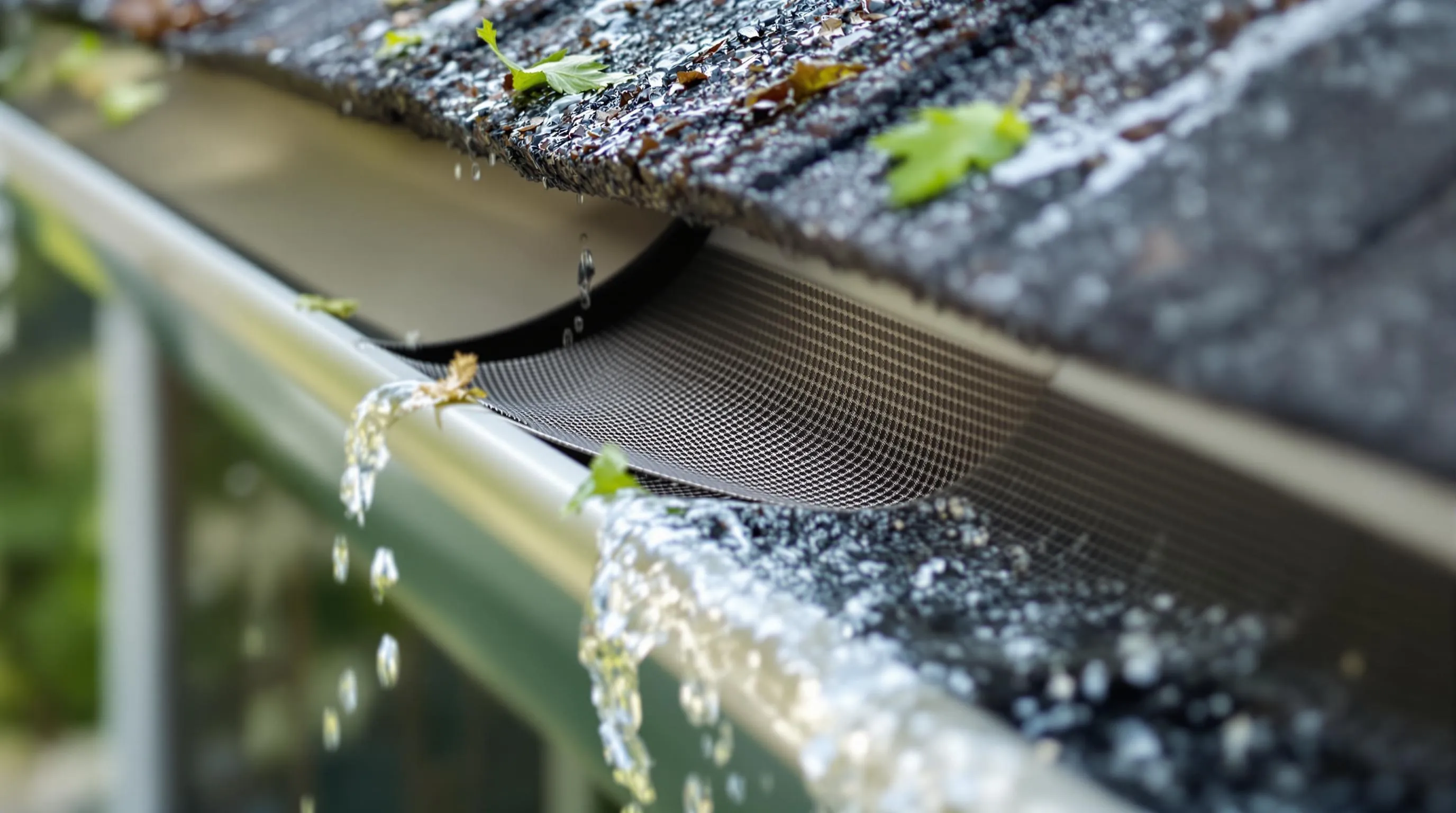
Mesh and screen filtration systems serve as the critical first barrier against contaminants in your rainwater harvesting setup. These simple yet effective answers prevent leaves, twigs, insects, and other debris from entering your collection system, protecting downstream components and improving overall water quality.
Fine Mesh Screens for Debris Removal
Fine mesh screens are essential components that trap larger particles before they can enter your rainwater storage system. Available in various mesh sizes (typically 500-1000 microns), these screens effectively capture leaves, twigs, bird droppings, and insect remains. Installing these screens at your gutter outlets or downspouts creates a physical barrier that significantly reduces maintenance requirements for your entire system. For optimal performance, select stainless steel or marine-grade materials that resist corrosion and UV damage, extending the lifespan of your filtration system. Many homeowners find that angled installations (around 30°) improve self-cleaning capabilities as debris naturally slides off during heavy rainfall.
Self-Cleaning Screen Filters
Self-cleaning screen filters represent an advanced solution for hands-off maintenance of your rainwater collection system. These innovative filters use either water pressure or mechanical brushes to automatically remove accumulated debris from the screen surface without manual intervention. Models like the WISY WFF and RainHarvest Systems’ Downspout Filter incorporate unique flushing mechanisms that activate during heavy rainfall, directing the first flow of dirty water and debris away while allowing cleaner water to pass through. Most self-cleaning units require installation at a minimum height of 31 inches above your storage tank to ensure proper function. While these systems typically cost $150-$400 more than standard mesh screens, they dramatically reduce maintenance time and extend the life of downstream filtration components.
First Flush Diverters: Improving Water Quality From the Start
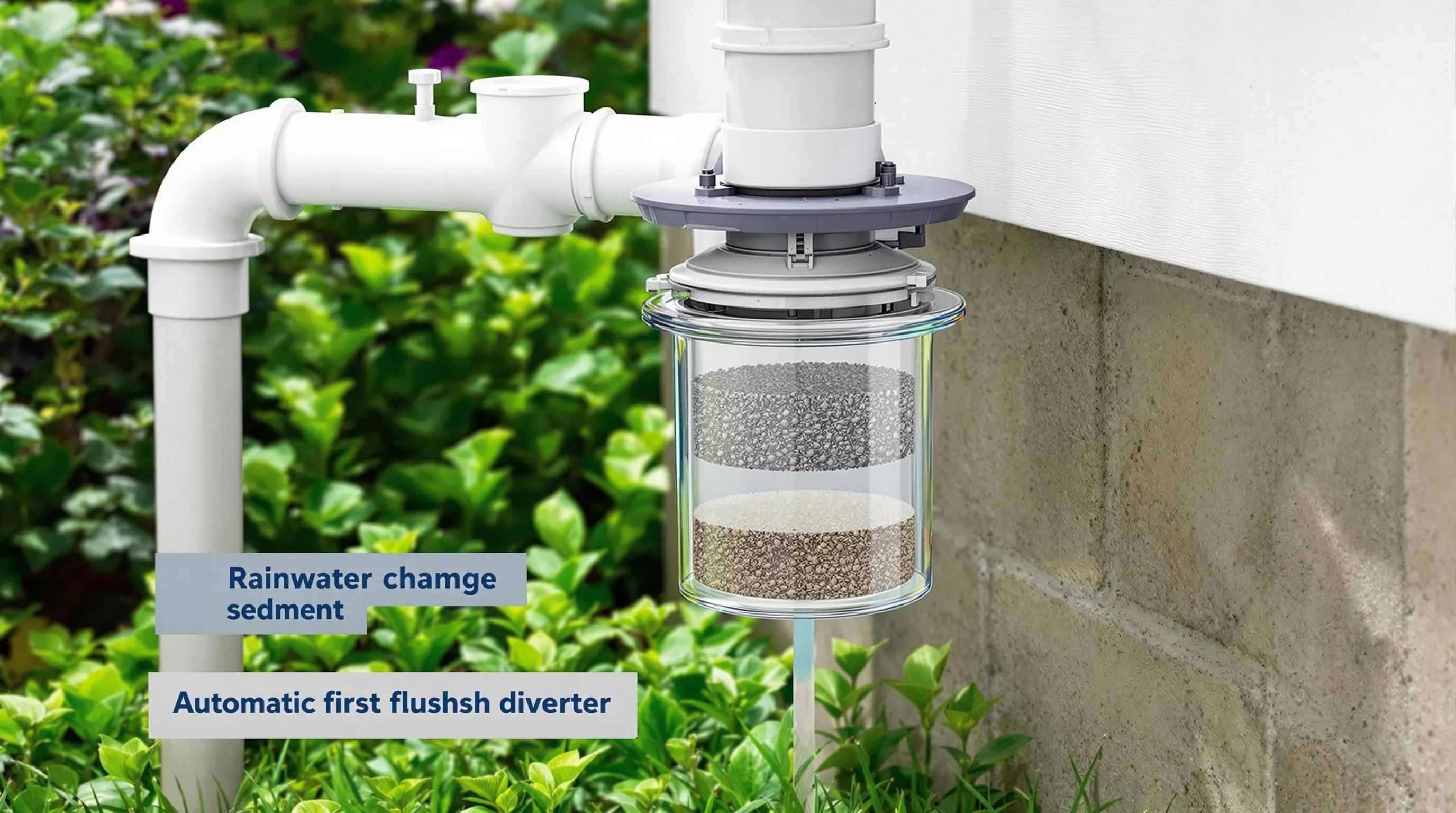
First flush diverters are essential components that significantly improve rainwater quality by capturing and diverting the initial rainfall that contains the highest concentration of contaminants. These simple yet effective devices prevent dirt, bird droppings, leaves, and pollutants that accumulate on your roof between rain events from entering your storage tank.
Automatic First Flush Systems
Automatic first flush systems take the guesswork out of rainwater filtration by operating without manual intervention. These sophisticated units use floating ball mechanisms that seal off the diversion chamber once it’s filled, allowing cleaner subsequent rainwater to flow directly to your storage tank. Some advanced models feature programmable timers that automatically drain the diverted water after a preset period, eliminating maintenance hassles. Look for systems with transparent chambers that let you visually inspect sediment buildup and easily adjust diversion volumes based on your roof size and local pollution levels. While these systems require a higher initial investment (typically $150-300), they deliver consistent water quality and virtually eliminate the need for regular maintenance checks.
DIY First Flush Diverter Options
Creating your own first flush diverter is a cost-effective alternative that can be accomplished using standard plumbing parts from any hardware store. A basic DIY system uses PVC pipes, a floating ball, and a slow-release valve to divert the initial contaminated rainwater. For optimal results, design your diverter to capture the first 0.5-1 gallon of water per 100 square feet of roof area. Install the diverter at a downspout junction before water enters your main collection system, ensuring the chamber has a small drain hole or manually operated valve at the bottom for emptying between rainfalls. Many rainwater enthusiasts enhance their DIY systems with mesh pre-filters at the top to capture larger debris before it enters the diversion chamber. These homemade answers typically cost $30-75 depending on materials and can be customized to fit your exact roof configuration and local rainfall patterns.
Sand and Gravel Filters: Natural Filtration Solutions
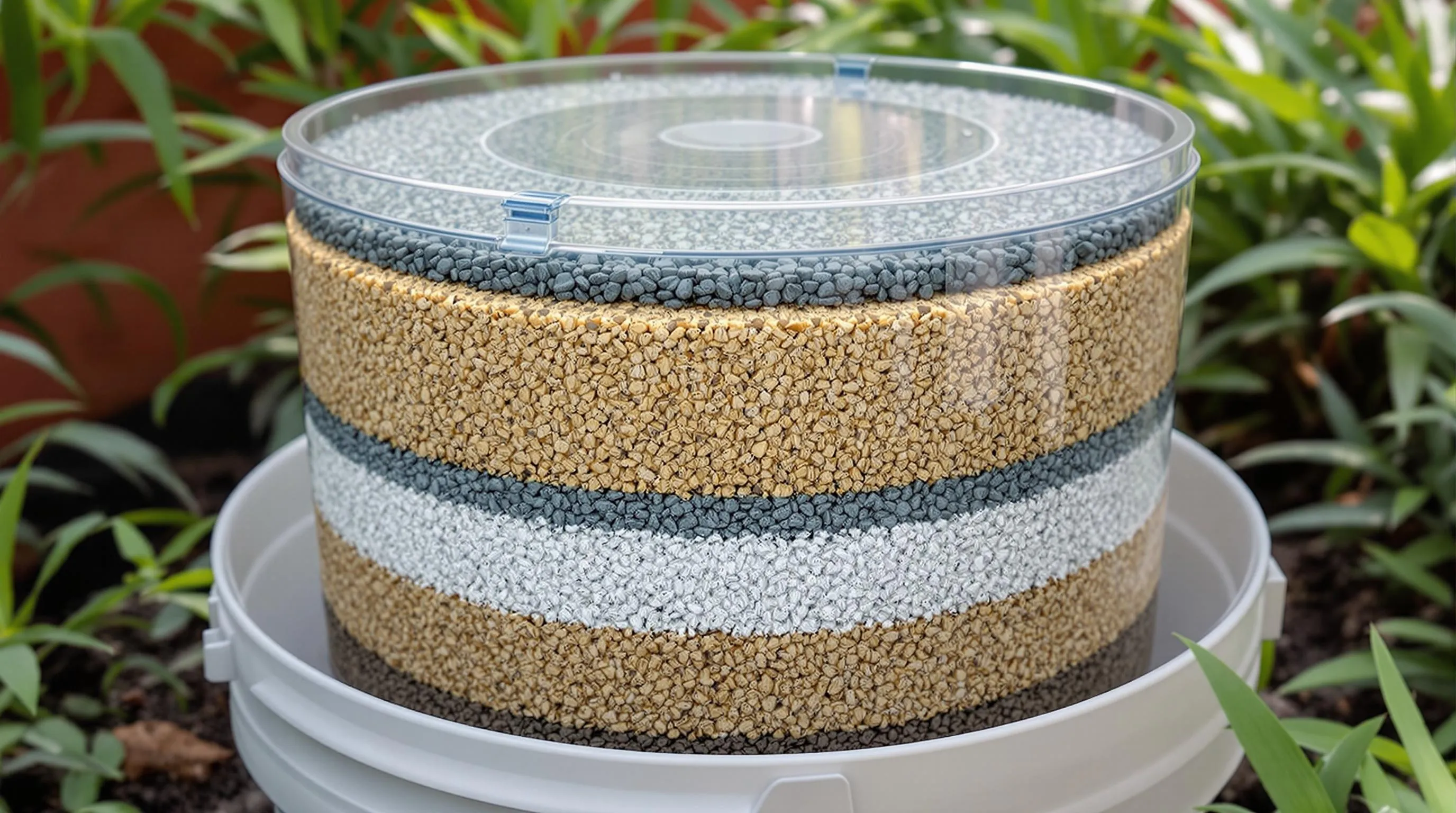
Sand and gravel filters provide an eco-friendly, chemical-free approach to rainwater filtration. These systems mimic nature’s own purification process, efficiently removing contaminants through multiple layers of natural materials.
Multi-Layer Sand Filter Designs
Multi-layer sand filters offer exceptional filtration through strategically arranged layers of varying materials. You’ll typically start with coarse gravel at the bottom (1-2 inches in diameter), followed by pea gravel, coarse sand, and finally fine sand at the top. Each layer becomes progressively finer, trapping different-sized particles as water percolates downward. For rooftop systems, compact designs using 5-gallon buckets or PVC pipes can be easily integrated into your downspouts. The most effective systems include a distribution plate at the top to prevent channeling and ensure even water flow through all layers. These filters require minimal maintenance—just occasional raking of the top sand layer every 3-6 months to prevent clogging.
Slow Sand Filtration for Rooftop Systems
Slow sand filtration harnesses biological processes to purify your rainwater, making it one of the most effective natural methods available. In these systems, water slowly passes through a bed of fine sand at a rate of 0.1-0.3 meters per hour, allowing a beneficial layer of microorganisms (called the schmutzdecke) to develop on top. This living layer naturally removes up to 99% of pathogens and organic contaminants. For rooftop applications, you can create a compact slow sand filter using a 55-gallon drum with a sand depth of at least 24 inches. The key to success is maintaining consistent moisture in the filter—even during dry periods—to keep the biological layer active. While these systems require 2-3 weeks to establish initially, they provide superior water quality with minimal intervention for up to several years before the sand needs replacement.
Activated Carbon Filters: Removing Contaminants and Odors
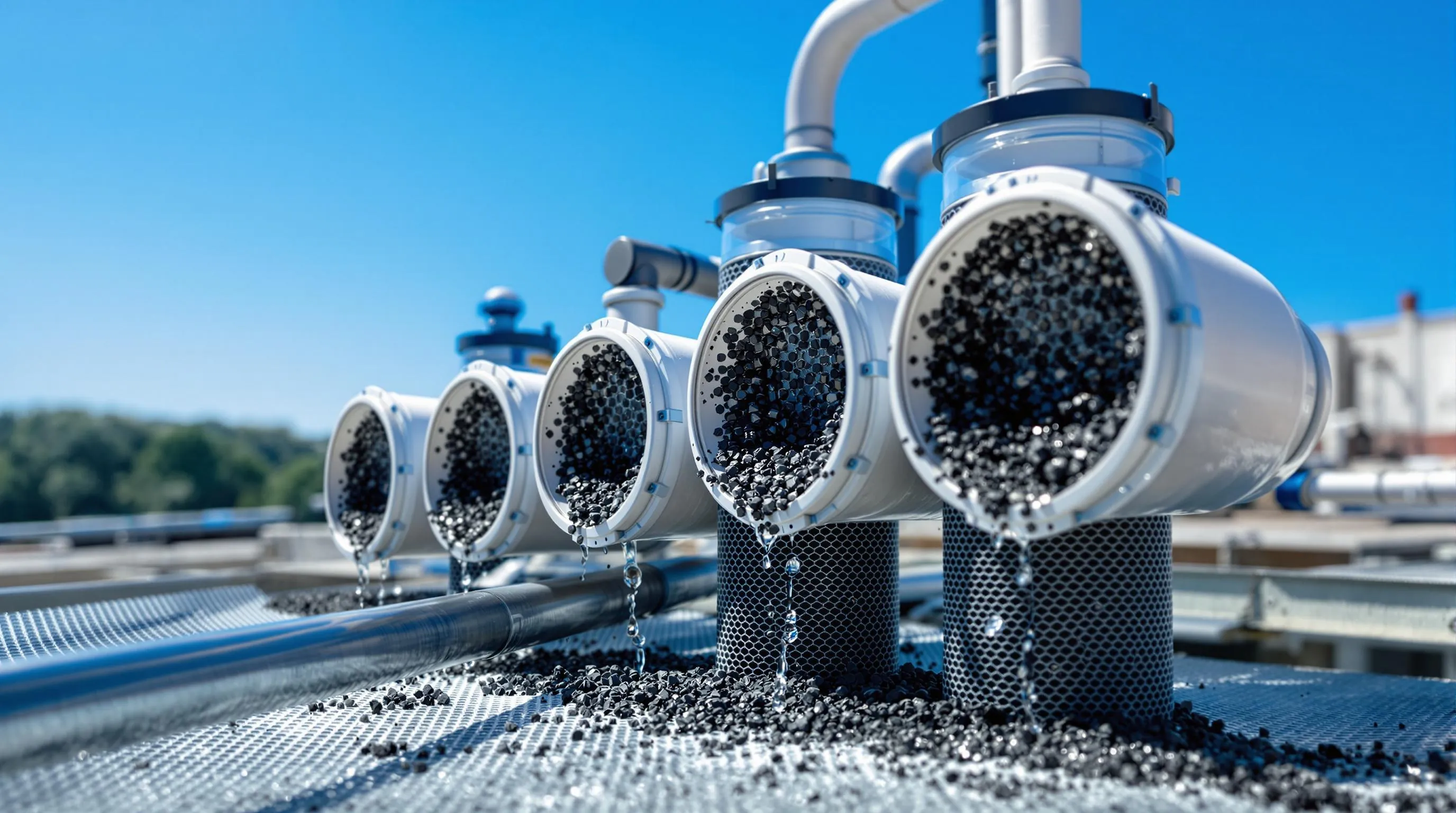
Activated carbon filters represent one of the most effective answers for improving rainwater quality by targeting microscopic contaminants that other filtration methods miss. These powerful filters use highly porous carbon material that creates a massive surface area for trapping chemicals, odors, and certain dissolved pollutants through adsorption.
Cartridge-Based Carbon Filters
Cartridge-based carbon filters offer a convenient and effective solution for your rooftop rainwater system. These filters typically consist of replaceable cartridges filled with activated carbon granules or blocks that trap contaminants as water passes through. You’ll find installation straightforward with most standard water filtration housings, making them adaptable to various system sizes. The cartridges require replacement every 3-6 months depending on rainfall volume and contamination levels. For optimal performance, look for cartridges with a 5-10 micron rating to remove volatile organic compounds, chlorine, pesticides, and unpleasant odors. Many homeowners install these filters as a secondary filtration stage after mesh screens and sediment filters for comprehensive water purification.
Combining Carbon with Other Filtration Media
Improving your rainwater filtration system’s effectiveness requires strategic media combinations. Pairing activated carbon with ceramic filters creates a powerful dual-action system that removes both chemical contaminants and biological threats. You can also combine carbon with KDF (Kinetic Degradation Fluxion) media to target heavy metals like lead and mercury while extending the carbon’s lifespan by up to 75%. For comprehensive filtration, consider multi-stage systems that incorporate sediment pre-filters, carbon cartridges, and final polishing filters. These integrated systems provide complete protection while minimizing maintenance requirements. The initial investment of $150-300 for a quality combined system pays off through superior water quality and reduced replacement frequency. Remember to position your carbon filter after coarser filtration stages to prevent premature clogging and maintain optimal flow rates in your rainwater harvesting system.
UV Filtration Systems: Advanced Purification Methods
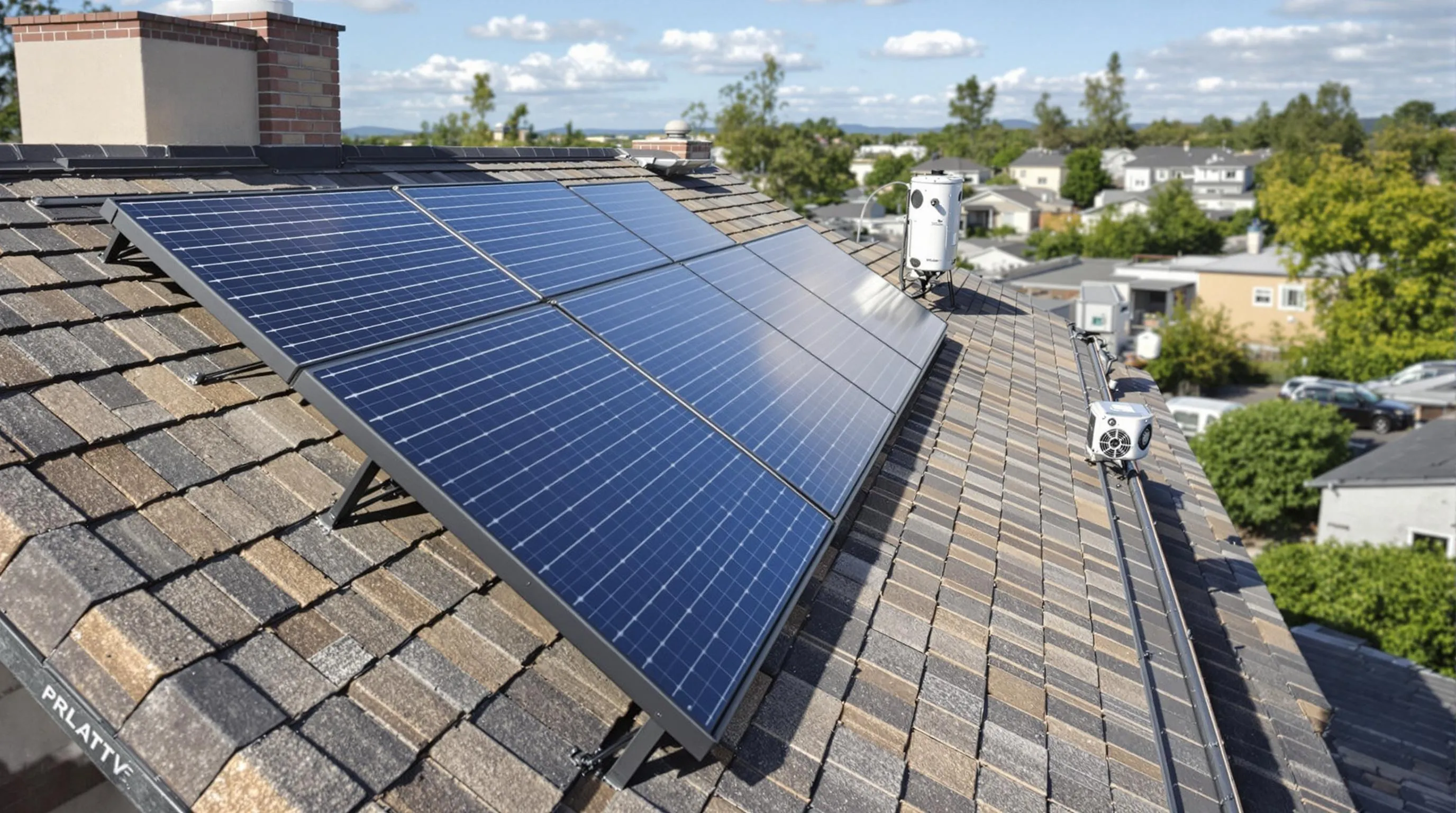
UV filtration systems represent one of the most effective methods for eliminating harmful microorganisms in your harvested rainwater. These systems use ultraviolet light to neutralize bacteria, viruses, and other pathogens without adding chemicals to your water supply.
Solar-Powered UV Filters
Solar-powered UV filters combine renewable energy with advanced water purification technology for an eco-friendly solution to rainwater treatment. These systems use photovoltaic panels to power UV lamps that emit germicidal wavelengths of 254 nanometers—precisely the range needed to destroy 99.99% of harmful microorganisms. With battery backup capabilities, you’ll have continuous protection even during cloudy periods or at night. Most solar UV systems require minimal maintenance beyond occasional lamp replacement (typically every 9-12 months) and solar panel cleaning. For optimal performance, install these units after sediment filtration to ensure clear water that allows maximum UV light penetration. Brands like Solaqua and SunPure offer complete systems starting at $350, making them increasingly accessible for residential rainwater harvesting setups.
Integrated UV and Mechanical Filtration
Integrated UV and mechanical filtration systems provide comprehensive water treatment in a single, space-efficient unit. These all-in-one answers incorporate multiple filtration stages—typically a 5-micron sediment filter, an activated carbon filter, and a UV chamber—ensuring your rainwater is free from particulates, chemicals, and microorganisms. The sequential design prevents larger particles from shielding microbes during UV exposure, significantly improving disinfection efficiency. Many modern integrated systems include smart features like flow sensors that adjust UV intensity based on water flow rates and automatic shut-offs that prevent untreated water from passing through during power outages. For rooftop applications, compact wall-mounted models like the Viqua IHS22-E10 or the Pentek UV-INT-120 offer reliable performance while occupying minimal space in your filtration setup. Regular replacement of pre-filters (every 3-6 months) and annual UV lamp changes will keep these systems operating at peak efficiency.
Vortex Filters: Efficient Separation Technology
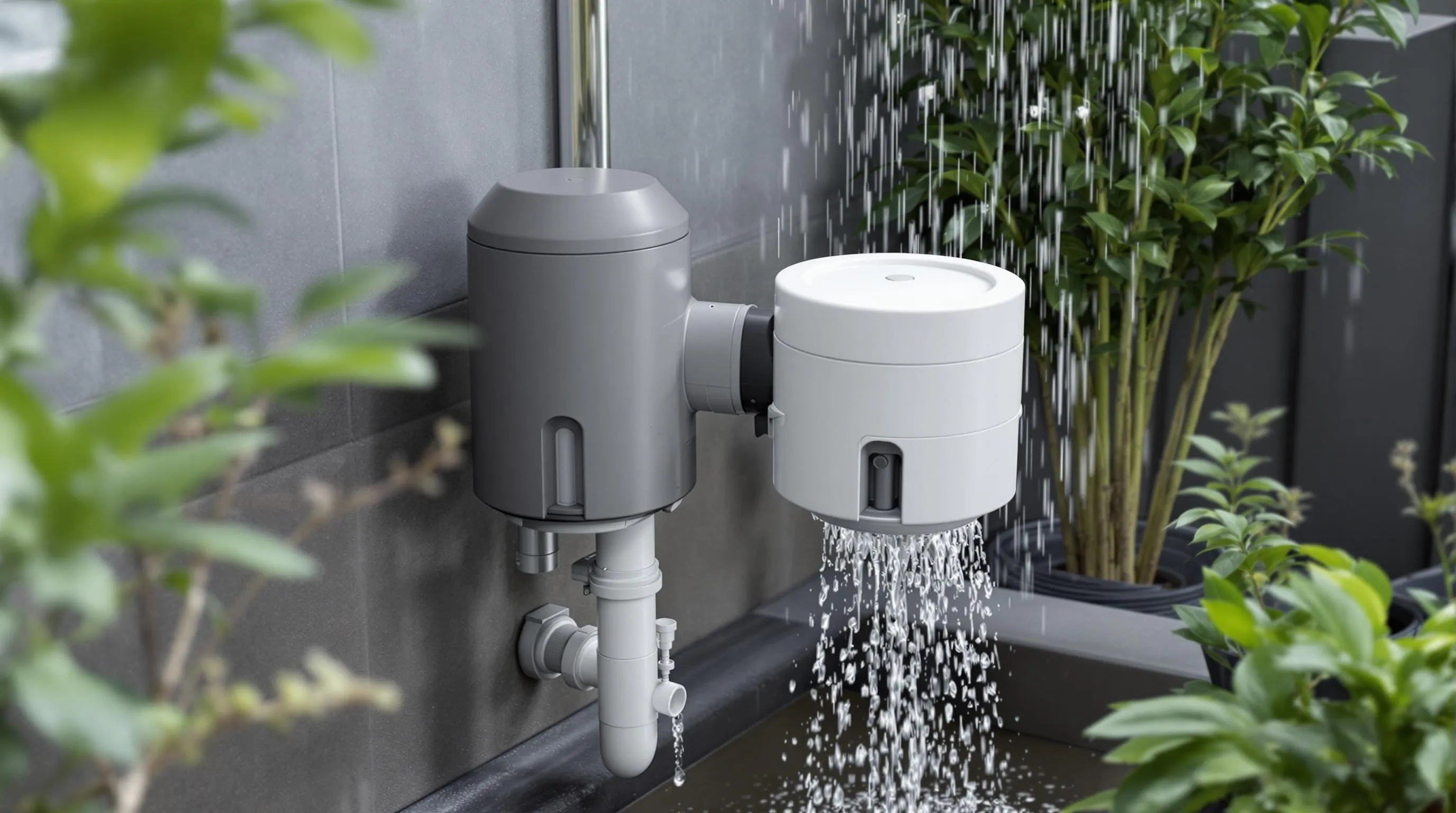
Vortex filters leverage centrifugal force to separate debris from rainwater with minimal maintenance. These innovative filters create a spinning motion that forces heavier particles to the perimeter while allowing cleaner water to flow through the center, achieving filtration efficiencies of 90-95% in optimal conditions.
Compact Vortex Filters for Limited Spaces
Compact vortex filters offer powerful filtration performance even though their small footprint, making them ideal for urban homes with limited installation space. These space-efficient units typically measure just 12-18 inches in diameter while processing up to 200 gallons per minute. Install these filters directly in your downpipe system for seamless integration that doesn’t compromise your roof aesthetics. Most compact models feature self-cleaning capabilities that flush debris automatically during heavy rainfall, reducing maintenance to just quarterly inspections. For maximum efficiency, position compact vortex filters at height differentials of at least 12 inches between inlet and outlet to maintain proper hydraulic flow.
High-Capacity Vortex Systems for Large Rooftops
High-capacity vortex filters are engineered to handle substantial water volumes from extensive roof areas exceeding 3,000 square feet. These robust systems can process 500+ gallons per minute while maintaining filtration efficiency even during intense downpours. Connect multiple downpipes to a single high-capacity vortex unit to centralize your filtration system and simplify maintenance routines. Look for models with integrated overflow protection and adjustable flow controls to manage seasonal rainfall variations effectively. Premium high-capacity systems incorporate stainless steel filter elements and UV-resistant housings that withstand harsh weather conditions for 15+ years, making them cost-effective even though higher initial investment. Many manufacturers now offer remote monitoring capabilities that alert you to performance changes or maintenance needs via smartphone apps.
Green Roof Integrated Filters: Dual-Purpose Solutions
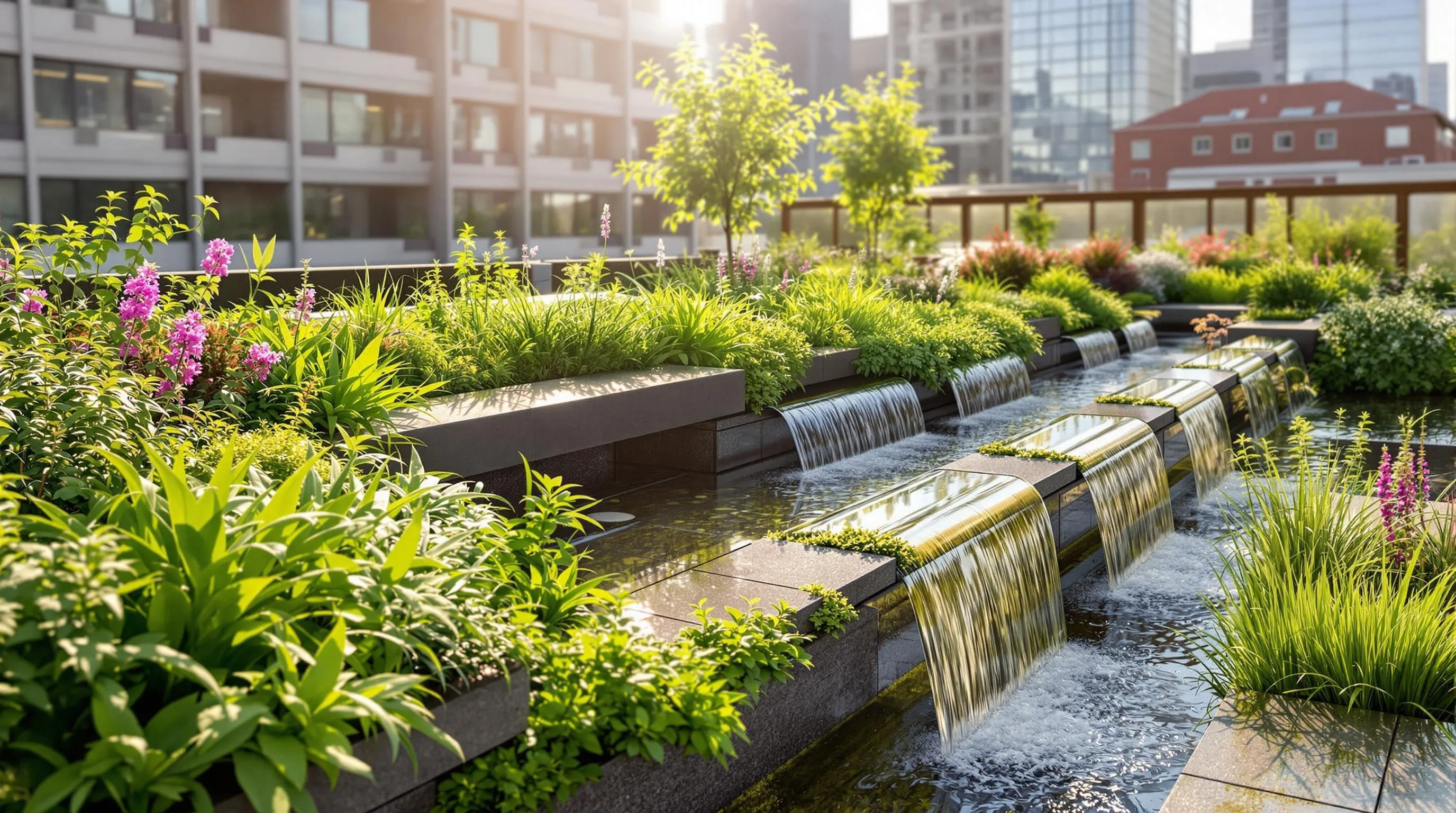
Green roof integrated filters combine the aesthetic and environmental benefits of rooftop gardens with practical rainwater filtration. These systems maximize your roof space by serving dual purposes—beautifying your property while naturally purifying rainwater before collection.
Living Filter Systems
Living filter systems transform your roof into an active bio-filtration mechanism by integrating exact vegetation layers with traditional filter media. These systems capture 70-90% of pollutants as rainwater flows through plant roots, soil media, and drainage layers. You’ll benefit from reduced runoff volume by 50-60% during moderate rainfall events since plants absorb important water quantities. The multi-layered composition typically includes drought-resistant sedums, native grasses, and perennials planted in engineered soil blends that filter particulates down to 10 microns. For optimal performance, install these systems with slope-appropriate flow paths that direct filtered water to collection points without creating stagnant areas.
Plant-Based Biofiltration Options
Plant-based biofiltration options leverage exact plant species’ natural filtration capabilities to remove contaminants from rainwater. You can create modular raingardens using plants like rushes, sedges, and ferns that excel at removing heavy metals and organic pollutants with removal rates of up to 95% for common rooftop contaminants. These systems require 4-6 inches of specialized substrate including biochar and expanded clay pellets to maximize filtration efficiency. The rhizosphere—the area surrounding plant roots—hosts beneficial microorganisms that break down complex pollutants into harmless compounds. For urban settings, consider compact wall-mounted plant filters that cascade water through multiple plant layers before collection, maximizing filtration in minimal space while creating stunning vertical gardens that enhance your building’s appearance.
Smart Filtration Systems: Technology-Enhanced Solutions
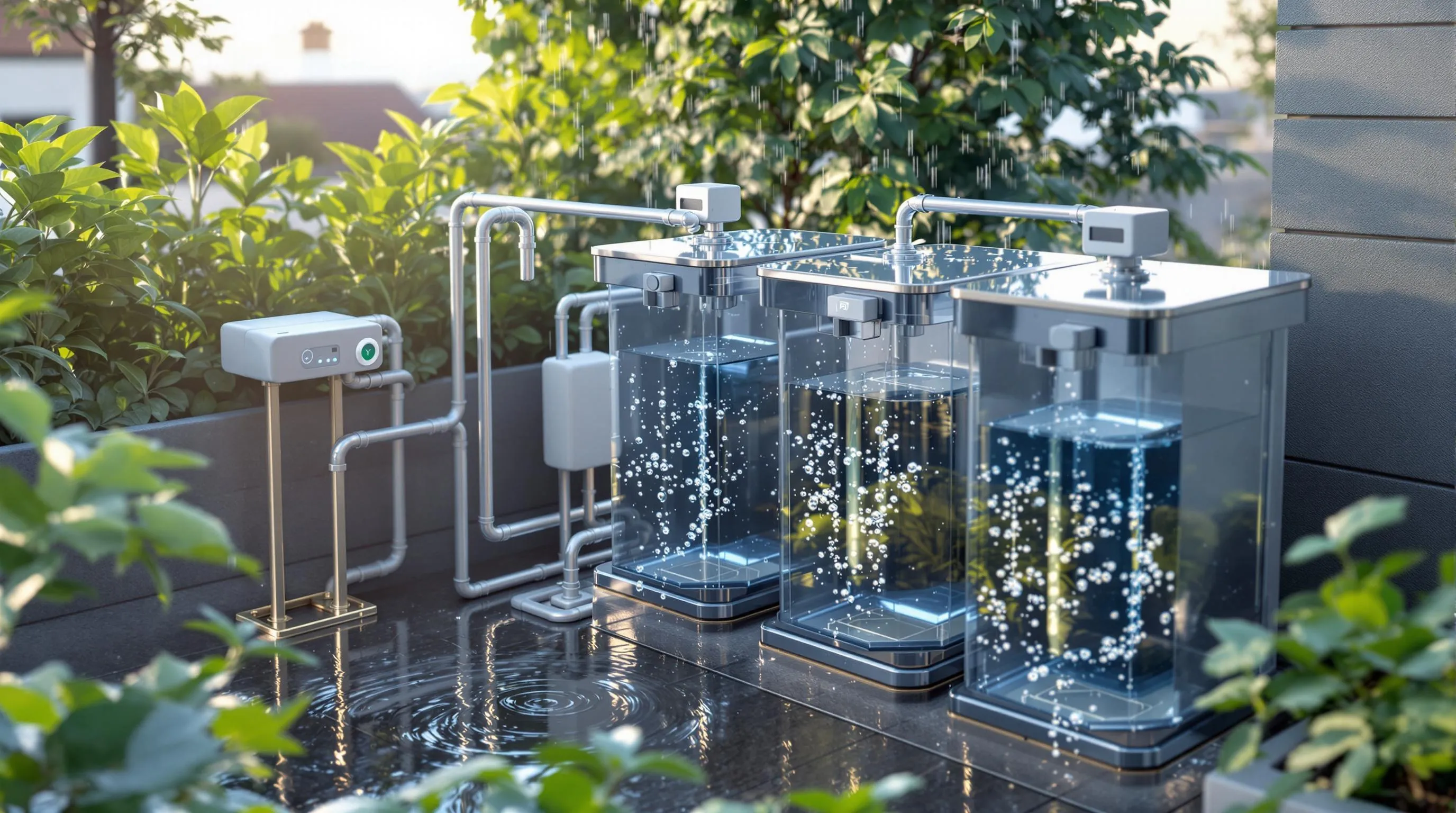
IoT-Connected Rainwater Filters
IoT-connected rainwater filters represent the cutting edge of water harvesting technology. These smart systems incorporate sensors that continuously monitor water quality parameters like turbidity, pH, and contaminant levels in real-time. You’ll receive instant alerts on your smartphone when filter performance declines or maintenance is needed, eliminating guesswork about filter condition. Many models offer comprehensive data tracking through dedicated apps, allowing you to analyze rainwater quality trends over time and optimize your system accordingly. Premium IoT filters integrate with home automation systems, automatically adjusting filtration intensity based on detected pollution levels or diverting water to different uses based on its quality. With prices ranging from $200 for basic models to $600+ for advanced systems, these smart filters provide unprecedented control and monitoring capabilities for serious rainwater harvesters.
Automated Cleaning and Maintenance Systems
Automated cleaning systems eliminate the most tedious aspect of rainwater harvesting—regular filter maintenance. These self-cleaning filters incorporate innovative mechanisms like motorized brushes that activate on predetermined schedules or when sensors detect pressure drops indicating clogging. Backwash systems automatically reverse water flow through filters to dislodge trapped contaminants, extending filter life by up to 300% compared to manual cleaning. For comprehensive protection, some models feature dual-action cleaning with both mechanical scrubbing and high-pressure water jets that thoroughly remove accumulated debris. The most advanced systems include predictive maintenance algorithms that learn from your exact environmental conditions, optimizing cleaning cycles based on factors like rainfall patterns and seasonal debris accumulation. While costing 30-50% more than standard filters initially, these automated systems deliver important long-term savings through reduced maintenance hours and extended component lifespan.
DIY Rainwater Filter Projects: Budget-Friendly Alternatives
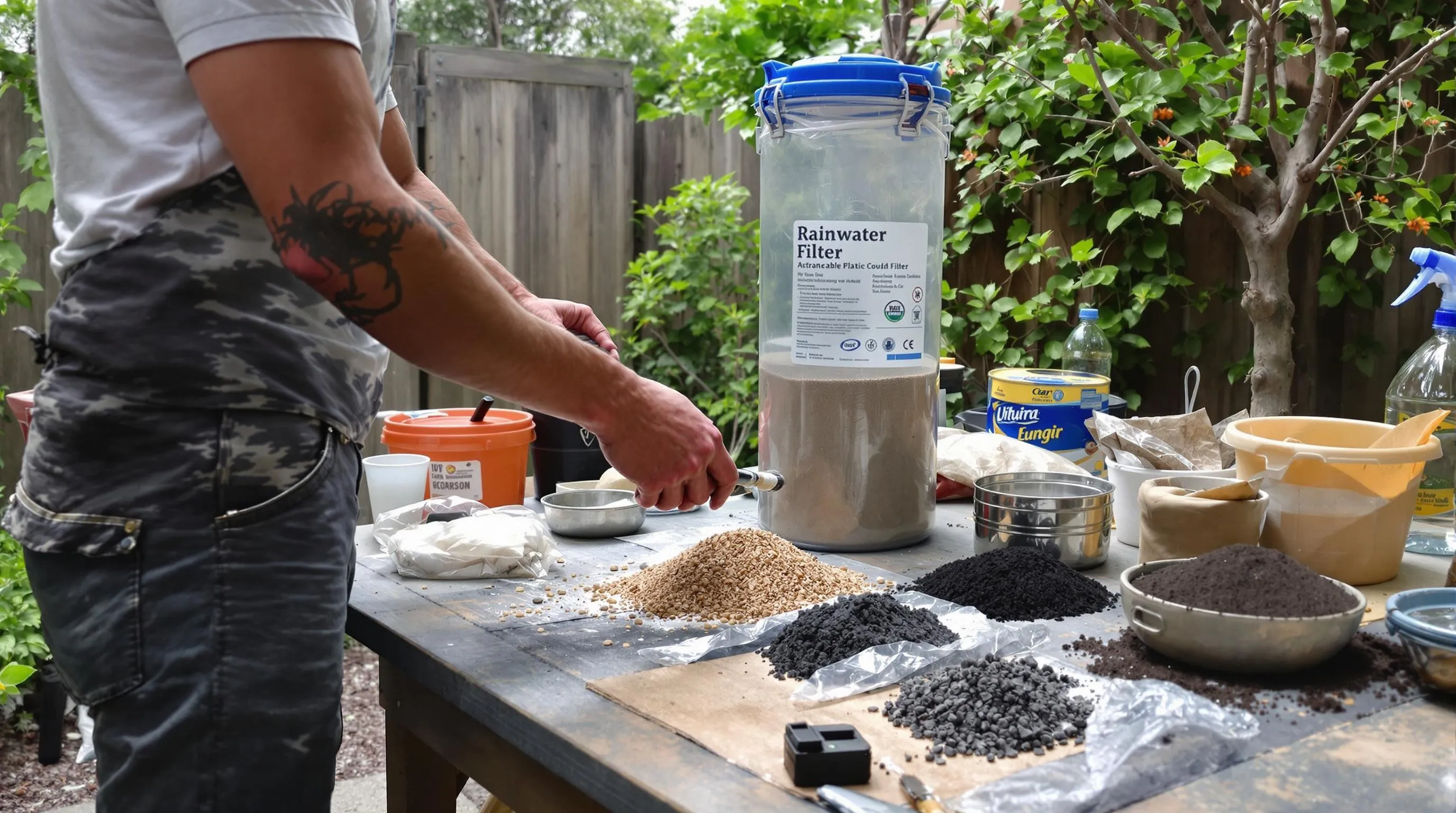
Creating your own rainwater filtration system doesn’t have to expensive. These DIY answers offer effective filtration while keeping costs down, making rainwater harvesting accessible for homeowners on any budget.
Repurposed Container Filters
Repurposed container filters transform everyday household items into effective rainwater filtration systems. Five-gallon buckets serve as perfect vessels for multi-stage filtration—simply stack them vertically with different filtering media in each layer. Old plastic storage bins can be converted into larger sediment traps by cutting inlet and outlet holes and adding mesh screens. Clean, food-grade barrels provide excellent options for constructing slow sand filters with minimal investment. Repurposing these containers not only saves money but also reduces waste, with most DIY bucket filters costing under $30 compared to $100+ for commercial alternatives. For best results, thoroughly clean all containers before use and seal connections with waterproof silicone to prevent leaks.
Step-by-Step Filter Construction Ideas
Building your own multi-layer filter system is straightforward with the right materials and approach. Start by gathering supplies: a 55-gallon food-grade drum, PVC fittings, and filtration media (coarse gravel, fine gravel, sand, and activated charcoal). Drill inlet and outlet holes at appropriate heights, then install bulkhead fittings to ensure watertight connections. Layer your materials from bottom to top: 4 inches of coarse gravel, 3 inches of fine gravel, 6 inches of sand, and 2 inches of activated charcoal. Add a removable mesh pre-filter at the inlet to capture larger debris. This construction method creates a filter that removes up to 99% of contaminants and costs approximately $50-75 to build—significantly less than commercial systems with similar performance. For enhanced effectiveness, add a small layer of copper mesh between charcoal and sand to provide antimicrobial properties.
Maintenance Tips for Rooftop Rainwater Filters: Ensuring Longevity and Efficiency
By implementing the right rooftop rainwater filter for your needs you’ve taken a important step toward sustainable water management. Whether you’ve chosen a sophisticated vortex system or built your own DIY solution remember that regular maintenance is essential for optimal performance.
Check your filters monthly during heavy rainfall seasons and clean or replace components as needed. Remove accumulated debris from screens and flush diverters to prevent clogging. For advanced systems like UV filters ensure bulbs are replaced according to manufacturer specifications.
With proper care your rainwater harvesting system will provide clean water for years to come while reducing your environmental footprint and water bills. The perfect filtration solution balances effectiveness simplicity and sustainability—making rainwater harvesting accessible and practical for any household.





